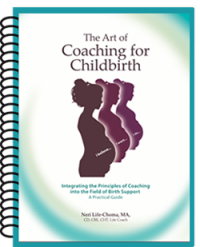
The Birth Plan from a Coaching Perspective
Is birth plan the goal or the strategy?
When birth workers, such as doulas and childbirth educators, first envisioned the birth plan in the eighties, the main idea was to help expectant parents prepare for the physical and emotional aspects of the birth process, explore how they want various situations handled during their actual birth, and provide a tool for parents to communicate with each other, their care provider, and the hospital staff prior to the birth (Simkin, 2007; Simkin & Reinke, 1980). As sometimes happens, the mean comes to be associated with the goal, and as such, expectant couples and some birth workers, associate writing the birth plan with achieving it. This association may evoke some unexpected outcomes:
Couples and their support figures might get attached to the ‘plan’ and react with rigidity to unpredictable situations during the birth and after
- Couples tend to get attached to the choices they checked on their plan and react with rigidity to unpredictable situations, such as imposed medical conditions or restrictions.
- Couples tend to assume that when they write a birth plan and hand it to their care providers, the later become accountable for their birth experience. This is true even when it comes to their birth doula; I have heard many doulas who share that they feel their clients are not committing to the steps which will bring them closer to achieving their birth plan, and yet expecting the doula or the medical staff to deliver these magical results.
- Couples’ vision and desired experience remain fragmented rather than becoming a compelling and motivating vision of the birth process. This fragmentation is misleading because it obscures the fact that birth is not an event or a list of small events, but rather flowing and unpredictable process.
- The medical staff uses this digital format of check-boxes to standardize the care and therefore handing them a birth plan in this format doesn’t lead to the desired individualized care.
Can you reduce the possible negative implications of writing a birth plan?
Fragments of the desired experience might not come together to create a compelling vision, nor do they evoke the emotional engagement or motivation needed to achieve it
Reflecting on the process of writing the birth plan from the perspective of Coaching for Childbirth, can help us reduce, or even eliminate, the undesirable aspects that currently present themselves in the writing process. When coaches begin leading a new client, they invest a good amount of time clarifying their clients’ goals or desired experiences. We ask our clients: “What will you see, hear, and feel when you go through your desired birth experience?” We help our clients make their goals as achievable and compelling as possible, by eliciting the states or experiences associated with the goals. Nevertheless, we make sure that our clients’ goals are very specific – we search for the details of the client’s desired experience, and for the steps needed to achieve them. In comparison, most birth plan templates that I have seen are in the format of a checklist. In my opinion, this digital format is in contrast to the idea of a compelling birth experience. It bears the potential to remain an itemized list instead of a vision. In other words, fragments of the desired experience might not come together to create a compelling vision, nor do they elicit the emotional engagement or motivation needed to fulfill the vision, whereas a vision can be broken into its parts and steps in order to become achievable.
Another disadvantage of this digital format of check-boxes is that it is the same format used by medical figures in order to provide standardized medical care. Therefore, this format shouldn’t be used in order to individualize care.
The following coaching strategies can assist you with the process of writing a birth plan:
I suggest that you begin the prenatal process by asking your birth client: “What are the achievable outcomes of the prenatal coaching process? This question and the ones below will help you clarify the desired experience:
You can shift the focus from the itemized list to the vision, and from the process of writing the preference list to the steps needed to manifest their vision
- What will you see, hear, and feel when you go through your desired birth experience?
- What specifically do you want?
- What is the next action you need to take in order to achieve your desired birth experience? Can we think about the future steps following this one?
- Do you know why you chose this experience; what is your motivation?
- Are you the only person in charge of your results, or are there others involved who need to be aligned with your vision?
- Is it achievable? Do you know of anyone who has achieved it before? How did they do it and what resources did they rely on?
- What resources do you have that will assist you in achieving your desired birth experience? (knowledge, skills, and strengths, support group)
Make sure your clients have a good answer to the nurse’s question: “How did you prepare yourself physically and mentally for the desired birth desired by this birth plan?”
This process allows the integration of the birth plan template as a strategy to specify the desired experience. For example, you may suggest looking at the template while discussing question (#2): If your birth client doesn’t know the specific details of her desired experience, you might say: “Would you like us to look at this list of options to help you specify the details of your desired experience”? Or you can mention the birth plan in question (#3) as one of the future steps which will help clarify her options. The conversation about question (#5) is also a suitable one to bring up the birth plan as a strategy to communicate the client’s birth vision with others who take part as decision-makers during her birth – the care providers. In all these potential moments you can make sure that the list is only a strategy, and is neither the goal nor the desired experience.
This new perspective- seeing the birth plan as a strategy to either:
- Specify the vision or
- Communicate the clients’ wishes with others, rather than seeing it as the vision itself
may reduce the couples’ potential attachment to the itemized list, which tends to create rigidity. You may also find that it can eliminate your clients’ temptation to hold the medical staff, or you, accountable to the fulfillment of their desired experience. You are shifting the focus from an itemized list to the vision, by means of eliciting their emotional and mental engagement and making sure your clients understand that the step of writing the birth plan is a strategy in their process towards their desired birth and not the goal. This understanding will lead to a higher level of accountability for their process, regardless of the unpredictable unfolding of the experience of childbirth.
- Overshadowing the Transformative Essence of Childbirth with Data - July 10, 2024
- Navigating the Epidural Dilemma - May 28, 2024
- Informed Decision in Birth Support: A Myth of Empowerment? - April 29, 2024
childbirth crisis moments, epidural, healthy birth, medical interventions in childbirth


